Key takeaways:
- Emphasizing storytelling and emotional connection is crucial for engaging donors and encouraging contributions to homeless charities.
- Building authentic relationships and maintaining transparency with donors fosters sustained support and trust in fundraising efforts.
- Being adaptable to changing circumstances and actively listening to donor feedback are essential for successful fundraising campaigns.
- Utilizing social media creatively and clarifying campaign goals can enhance outreach and make the impact of donations more tangible to supporters.
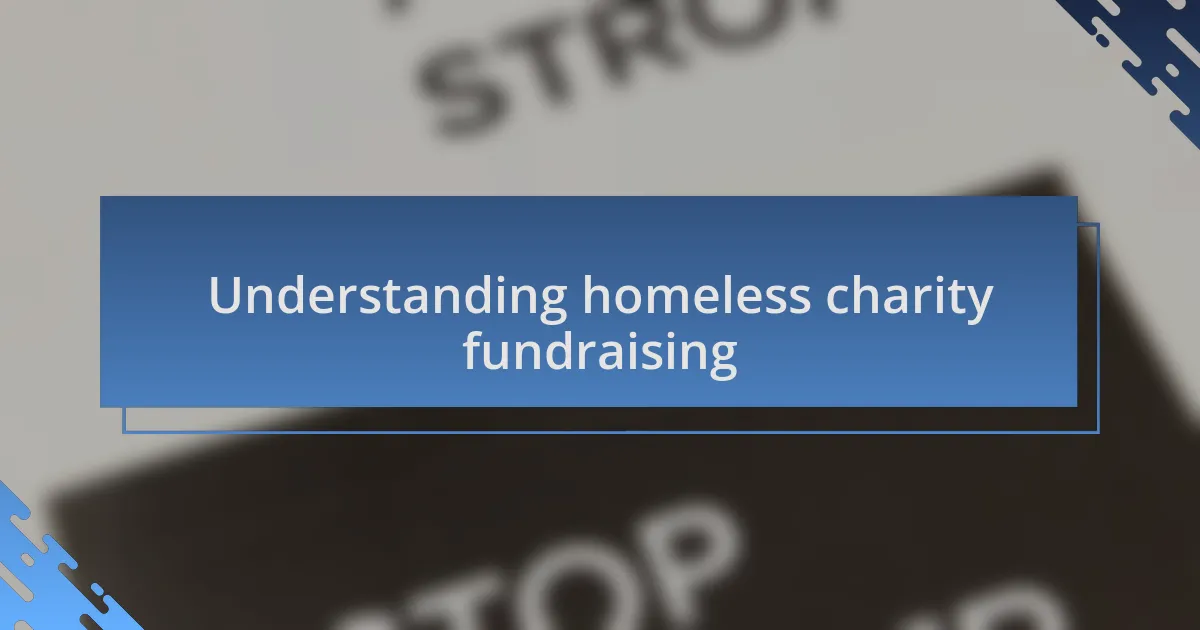
Understanding homeless charity fundraising
Understanding homeless charity fundraising goes beyond just collecting donations; it’s about connecting with people’s hearts. I remember one event where, despite having a brilliant marketing plan, we struggled to engage our audience emotionally. This experience taught me that storytelling is crucial—people want to know the impact of their contributions, not just the statistics.
When you’re fundraising for homeless charities, you quickly realize that it’s not just the money that matters, but the relationships you build along the way. I often found myself reflecting on why I started this journey in the first place. Isn’t it powerful to think that a simple conversation can change someone’s perception about homelessness and encourage them to contribute? That human connection can be the spark that ignites compassion and drives action.
I’ve learned that successful fundraising hinges on authenticity. Once, I shared a personal story about a friend who faced homelessness, and I saw how it resonated with others. The room filled with empathy, and within that moment, I realized how much more effective my fundraising efforts became when I brought my own experiences into the light. Achieving a genuine connection can lead to sustained support, making a real difference in the lives we aim to help.
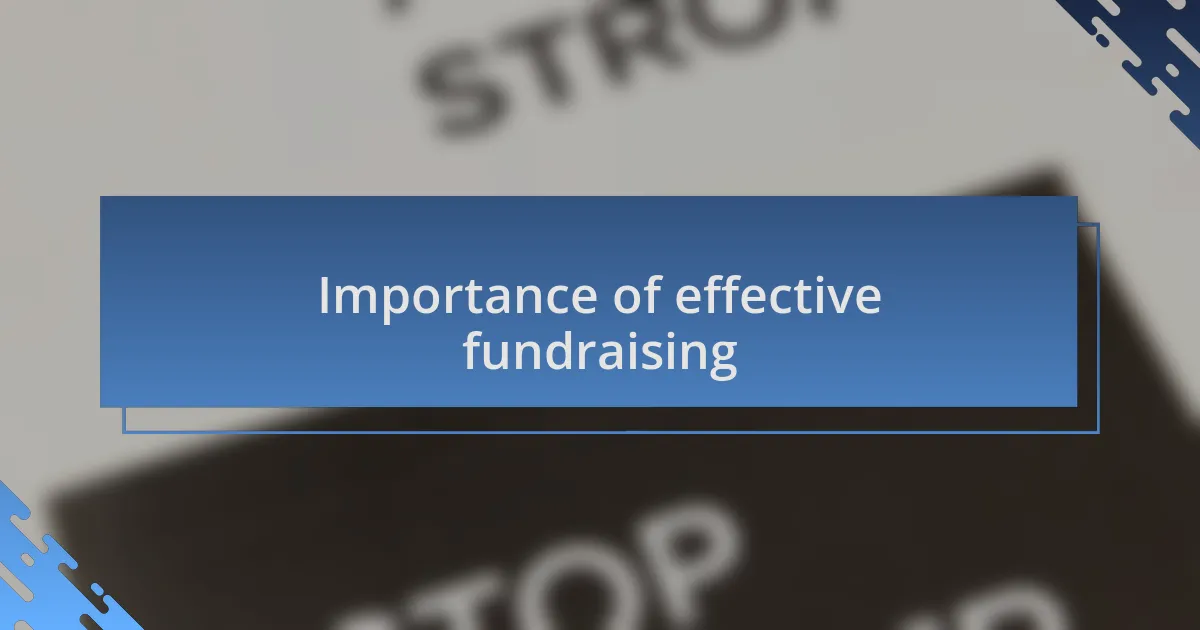
Importance of effective fundraising
Fundraising is not merely a financial transaction; it’s a lifeline for homeless charities. I remember a particular drive where we set a modest goal, and the community rallied beyond our expectations. It genuinely struck me—people are willing to give, but you must show them why their contributions matter. What stories are you sharing to inspire that kind of generosity?
Effective fundraising creates a ripple effect. I once collaborated with local businesses, turning their platforms into opportunities for action. Through those partnerships, not only did we raise funds, but we also raised awareness about homelessness in a way that statistics simply couldn’t. Isn’t it fascinating how engaging others not only bolsters resources but also encourages a shared mission? Building that sense of community around your cause can result in lasting support.
Understanding your donors’ motivations is crucial for sustainable fundraising. I recall having a conversation with a recurring donor who expressed their frustration over not seeing the tangible outcomes of their contributions. This moment reminded me that transparency is key. If donors feel connected to the impact of their generosity, they’re likely to continue supporting your mission. How can you ensure they’re part of the journey?

Common challenges in fundraising
Fundraising comes with its own set of unique challenges that can often catch organizations off guard. I vividly recall a campaign where we faced unexpected resistance from the community because they lacked trust in how funds would be utilized. This experience opened my eyes to the importance of establishing credibility early on. Without that foundation, it becomes incredibly tough to gain support—so how can organizations build trust in a world filled with skepticism?
Another hurdle is the sheer competition for attention and resources. During one particular event, I noticed that we were overshadowed by a larger, more established charity’s campaign happening simultaneously. It hit me then how vital it is to creatively differentiate your mission. I learned that storytelling and urgency could make a difference, but it requires continuous effort to ensure your cause shines bright amidst the noise. How can you package your message so it resonates and stands out?
Lastly, the emotional toll of fundraising should not be underestimated. I had moments of doubt and stress, especially when funding seemed uncertain and my team felt demoralized. It became clear that self-care and a supportive team environment are essential. When you feel overwhelmed, remember to focus on your ‘why’—this perspective can provide the resilience needed to push through challenging times. What practices do you employ to keep your team motivated when the road gets tough?
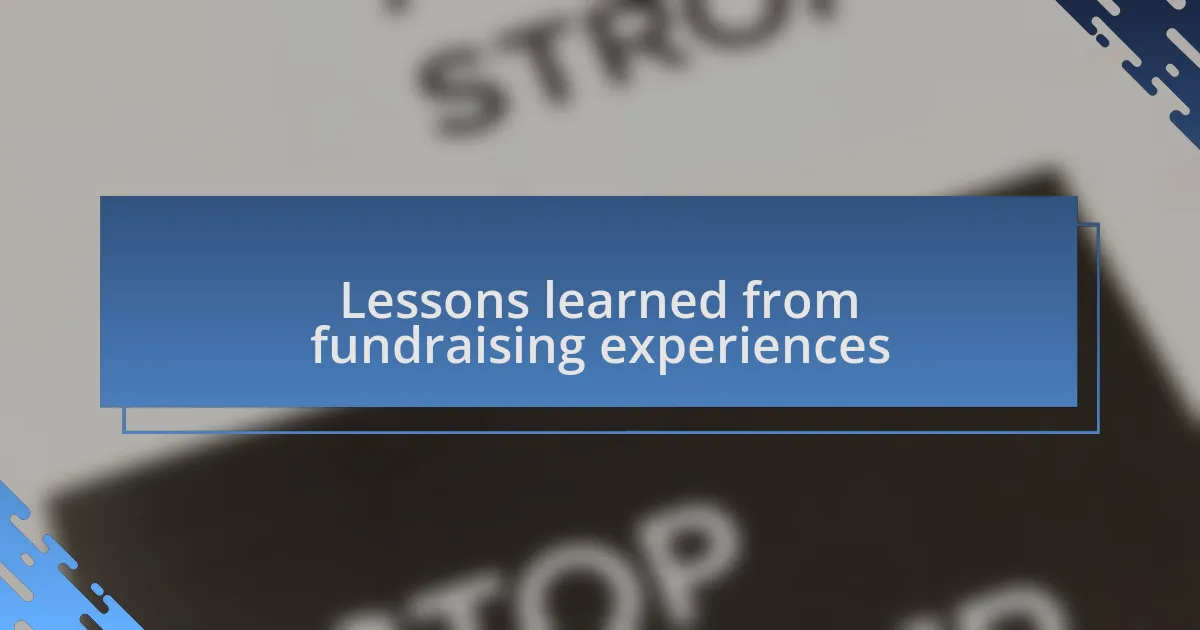
Lessons learned from fundraising experiences
In my experience, one of the most significant lessons has been the need for flexibility. During a campaign for a homeless shelter, I remember being so fixated on our initial plan that when things didn’t go as expected, I was caught off guard. I quickly learned that adapting strategies on the fly could mean the difference between success and failure. How do you find the balance between sticking to a plan and being open to change?
Another eye-opening moment came from realizing how crucial it is to listen actively to your supporters. At one fundraising event, I engaged with several donors who shared their thoughts on our approach, revealing insights I hadn’t considered. Those conversations not only strengthened relationships but also provided invaluable feedback for future initiatives. I found myself wondering: How can we better integrate donor perspectives into our strategies to ensure our efforts align with their passions?
The importance of celebrating small victories became increasingly clear over time. I recall a point during one fundraising drive where we reached a seemingly minor milestone, and I almost brushed it off. However, taking a moment to acknowledge that achievement boosted our morale and motivated the team to push harder. It got me thinking—how often do we pause to appreciate progress on the journey? Engaging with those small wins can keep the spirit alive, especially when the overall goal feels miles away.
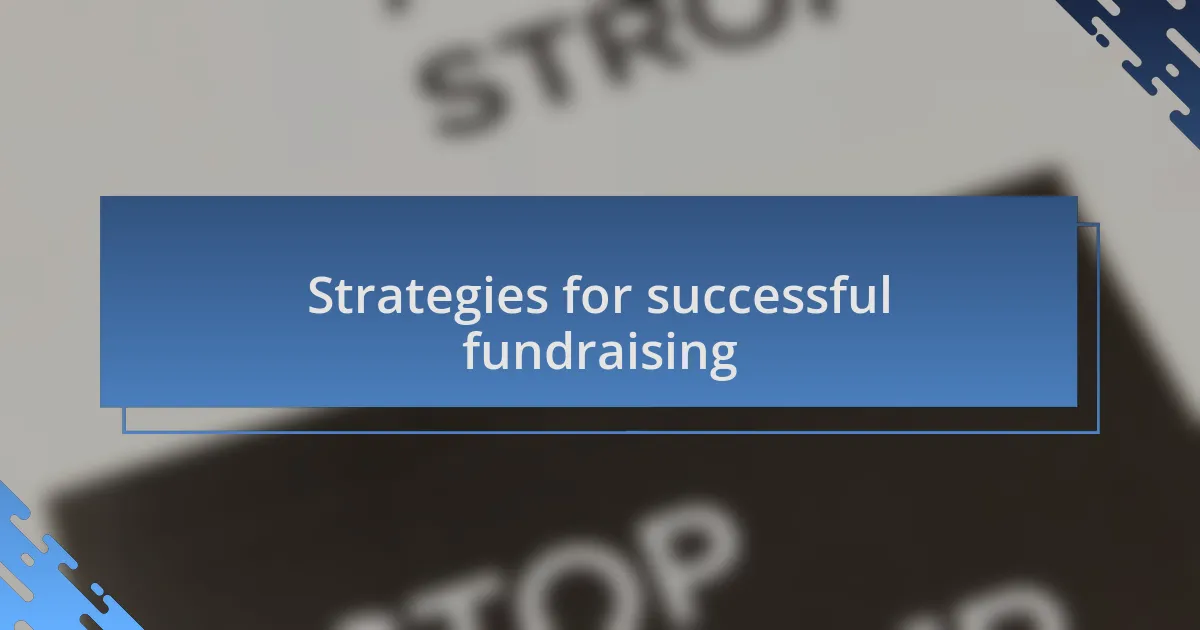
Strategies for successful fundraising
When fundraising, leveraging social media can be incredibly powerful. I remember launching a campaign on various platforms, creating eye-catching visuals and heartfelt stories that resonated with our audience. The engagement we received was astounding, and it made me realize just how essential it is to craft a compelling narrative that connects emotionally. How many more voices could we amplify through a simple hashtag?
Building partnerships can also enhance your fundraising efforts significantly. On one occasion, I collaborated with a local business that shared our mission. Their support not only increased our reach but also added credibility to our cause. I found myself asking: What unique partnerships could we forge that might open new doors and create a win-win situation for everyone involved?
Lastly, it’s critical to be transparent about how funds will be used. I recall a time when I shared a detailed breakdown with potential donors, explaining exactly how their contributions would make a difference. The response was overwhelmingly positive. In that moment, I understood that trust is the bedrock of successful fundraising. Are we doing enough to foster that transparency, ensuring our supporters feel truly connected to the impact of their generosity?
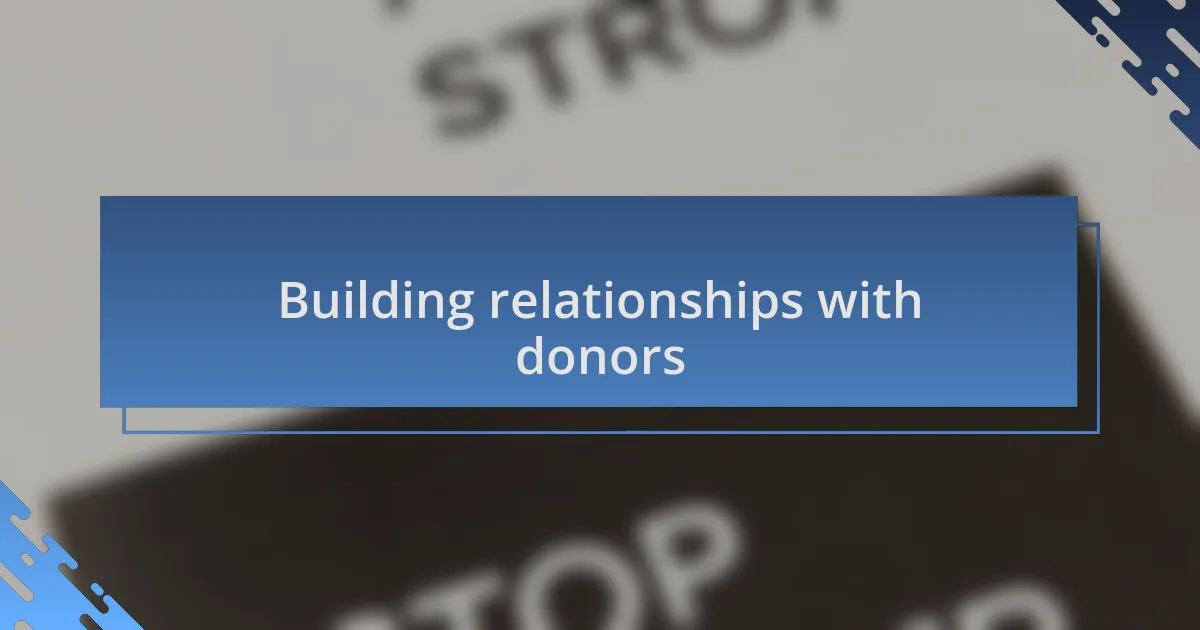
Building relationships with donors
Building relationships with donors goes beyond just financial transactions; it’s about creating a community around your cause. I remember attending a donor appreciation event where I had the chance to meet our supporters face-to-face. The shared stories and laughter made the experience much more memorable. Have you ever taken the time to simply thank your donors for their support? That recognition can truly deepen your connection with them.
Regular communication is key to nurturing these relationships. I found that sending monthly updates, not just about our successes but also the challenges we faced, allows donors to feel involved in the journey. It creates a sense of shared purpose. When I asked one of our long-term supporters what kept her engaged, she said it was knowing she was part of something bigger, not just a one-time donation. Are we effectively sharing our narrative with our donors?
Lastly, personalizing your outreach can make a significant impact. I often make it a point to send handwritten notes to donors after receiving their contributions. Those little gestures resonate deeply. One time, a donor shared how that small act made her feel truly valued. It’s incredible how a simple touch can foster loyalty and engagement. Are we taking the time to recognize our donors as not just contributors but as vital members of our mission?

Creating impactful fundraising campaigns
Creating impactful fundraising campaigns is all about storytelling. I vividly recall organizing a campaign where we shared real stories of people we helped. We showcased not just statistics, but the genuine experiences of individuals whose lives were transformed. This approach helped potential donors connect emotionally. Have you considered how your stories can resonate with those you want to reach?
Another critical aspect is clarity in your campaign goals. I remember a time when we set out to raise $50,000, clearly mapping out what that money would achieve. By breaking it down into tangible outcomes—like providing meals or shelter—we made it easy for donors to grasp the impact of their contributions. Do your potential supporters know exactly what their donations will accomplish?
Lastly, leveraging social media can amplify your message tremendously. During one campaign, we created a viral challenge that encouraged people to share their favorite memory of kindness. Not only did it spread our message widely, but it also built a sense of community around the cause. Have you explored ways that digital platforms can help your fundraising efforts? Engaging creatively with your audience can turn casual supporters into passionate advocates.